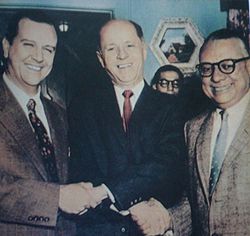
Punto Fijo Pact
Encyclopedia

Venezuela
Venezuela , officially called the Bolivarian Republic of Venezuela , is a tropical country on the northern coast of South America. It borders Colombia to the west, Guyana to the east, and Brazil to the south...
's three main political parties in 1958: Acción Democrática, COPEI
COPEI
Copei – Social Christian Party of Venezuela is a third way political party in Venezuela. The name stands for Comité de Organización Política Electoral Independiente...
and Unión Republicana Democrática, for the acceptance of the 1958 presidential elections
Venezuelan presidential election, 1958
General elections were held in Venezuela on 7 December 1958. The presidential elections were won by Rómulo Betancourt of Democratic Action, who received 49.2% of the vote, whilst his party won 73 of the 132 seats in the Chamber of Deputies and 32 of the 51 seats in the Senate...
, and the preservation of the rising democratic regime.
Origins
The term originates from Punto Fijo, Rafael CalderaRafael Caldera
Rafael Antonio Caldera Rodríguez was president of Venezuela from 1969 to 1974 and again from 1994 to 1999.Caldera taught sociology and law at various universities before entering politics. He was a founding member of COPEI, Venezuela's Christian Democratic party...
's house at the time in Caracas
Caracas
Caracas , officially Santiago de León de Caracas, is the capital and largest city of Venezuela; natives or residents are known as Caraquenians in English . It is located in the northern part of the country, following the contours of the narrow Caracas Valley on the Venezuelan coastal mountain range...
, where representatives of the Democratic Republican Union (URD), Social Christian (COPEI
COPEI
Copei – Social Christian Party of Venezuela is a third way political party in Venezuela. The name stands for Comité de Organización Política Electoral Independiente...
) and Democratic Action (Acción Democrática, AD) parties signed a pact that, according to its adherents, was aimed at preserving Venezuelan democracy by respecting elections, by having the winners of said elections consider including members of the signing parties and others to positions of power in bids for national unity government
National unity government
A national unity government, government of national unity, or national union government is a broad coalition government consisting of all parties in the legislature, usually formed during a time of war or other national emergency.- Canada :During World War I the Conservative government of Sir...
s, and by having a basic shared program of government.
According to others, the pact bound the parties to limit Venezuela’s political system to an exclusive competition between two parties. Some claim that the accord allowed the rising Venezuelan democracy to survive in the 60's the leftist guerrilla movement as well as destabilisation attempts by the Dominican Republic's right wing dictator, Rafael Leónidas Trujillo
Rafael Leónidas Trujillo
Rafael Leónidas Trujillo Molina , nicknamed El Jefe , ruled the Dominican Republic from 1930 until his assassination in 1961. He officially served as president from 1930 to 1938 and again from 1942 to 1952, otherwise ruling as an unelected military strongman...
. Nevertheless these visionary men sought consensus, not confrontation, as means to progress.
Fall out of favor
Eventually this pact became a political distribution of power between the two main political parties that signed it originating a bipartite system. Citizens, intellectuals, journalists and media started to demand a reformation of all the political system to transform Venezuelan democracy to fit a growing democratic society.Current Venezuelan president Hugo Chávez
Hugo Chávez
Hugo Rafael Chávez Frías is the 56th and current President of Venezuela, having held that position since 1999. He was formerly the leader of the Fifth Republic Movement political party from its foundation in 1997 until 2007, when he became the leader of the United Socialist Party of Venezuela...
promised in his 1998 presidential campaign
Venezuelan presidential election, 1998
In the Venezuelan presidential election of 1998, Hugo Chávez was elected to his first term as President of Venezuela with the largest percentage of the popular vote in four decades...
that he would break the old puntofijismo system and open up political power to independent and third parties.
Similar pacts
Puntofijismo bore a resemblance to the Turno pacifico of the restored Spanish monarchy between 1876 and 1923, in which Conservative and Liberal parties alternated in power.It also has some similarities with the National Front (Colombia)
National Front (Colombia)
National Front was a period in the history of Colombia in which the two main political parties; Liberal Party and Conservative Party agreed to let the opposite party govern, intercalating for a period of four presidential terms....
, which like the Puntofijismo was enacted in 1958 and ended a military regime. However, the National Front was also instituted to end a civil war between the two parties, and was a much more extensive pact which temporarily had the parties take turns with the presidency.
External links
- Pacto de Punto Fijo, in Spanish.

